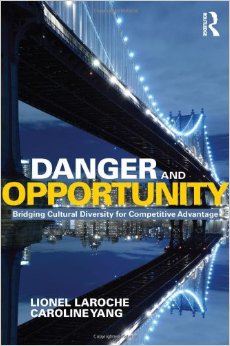
10 Questions for Marc Kielburger
January 21, 2015
Career Briefs
January 21, 2015By Jon Woodend, MSc

Canada was one of the first developed countries to adopt multiculturalism as an integral part of its identity. Because of this, Canada now has the highest proportion of foreign-born individuals, and its immigration system, which successfully attracts skilled workers, is heralded internationally. Given that the government of Canada will continue to seek skilled immigrant workers to offset a low domestic birthrate, the Canadian workforce will only continue to become more diverse. Lionel Laroche and Caroline Yang in their book Danger and opportunity: Bridging cultural diversity for competitive advantage note that, while the Canadian workforce may benefit from these skilled workers and their diverse skills, without multicultural awareness, these lucrative benefits can quickly turn into sour disadvantages for all involved.
As such, Laroche and Yang set up their book to help immigrant and Canadian-born workers, as well as managers and human resource professionals, navigate through these cultural minefields in order to maximize the experience for all. Specifically, Laroche and Yang use a multilayer circular model to represent the various areas relevant to working in a diverse workforce. This model serves as the roadmap of the book, and its various components are used as the chapter themes throughout. As a quick overview, at its outermost layer, the circular model suggests that there are three key influences:
a) People; their awareness, skills and communication style
b) Systems; the societal work process and tools, performance management and rewards
c) Environment; the workplace leadership, organization design and inclusive practices
Moving inward, there are four critical areas in which organizations and workers engage:
a) Managing a multicultural workforce
b) Working with offshore resources
c) Collaborating with joint venture partners
d) Competing in the global talent market
Finally, at the centre of the circular model, there are six factors related to individuals within the workplace. These factors are:
a) Their technical and soft skills
b) Their ability to communicate cross-culturally
c) Their understanding of cross-cultural feedback
d) Their sense of hierarchy
e) Their sense of individualism
f) Their propensity for risk tolerance
Throughout the chapters, Laroche and Yang explore the components of the circular model and offer rich anecdotal examples to clarify what these concepts look like within the workforce. These examples, as well as the audience addressed in the book, shift perspective to include the majority of individuals within the workforce. In particular, the book seems to be aimed at addressing the perspectives of immigrant and Canadian-born workers, supervisors, managers and human resource professionals, as well as the interactions between them. Within each chapter, Laroche and Yang go beyond using descriptions and concrete examples by providing visual representations of the concepts through their extensive use of diagrams. This approach helps the reader envision how these concepts would play out within their own work and practice. Specifically, the reader learns step-by-step ways to prevent cross-cultural misunderstanding, mediate conflict when it does occur, and maximize workplace teams’ strengths for optimal performance.
Although Laroche and Yang engage the audience in a variety of ways and shift perspective to provide an inclusive review of their circular model, there are a few areas for further development. First, the language used within the book is aimed at an audience with a higher understanding of English, rather than using more basic English. This may limit the book’s utility for less experienced English speakers and instead cater more to the well-educated, English-speaking professional. Second, in the first chapter Laroche and Yang talk about how conversations about discrimination are not productive and that often the discrimination is not purposeful, but the result of a misunderstanding. This diminishes the real experiences of immigrant workers who face discrimination within the workforce, and could be seen as an attempt to shift the responsibility of prevention onto the victims of discrimination. This discussion seems out of place with the inclusive nature of team responsibility stressed throughout the rest of the book, and perhaps the book would be better served by omitting it.
Overall, Laroche and Yang provide a comprehensive beginners’ guide to working effectively and competitively within a diverse workforce. Specifically, Danger and opportunity provides warning signs of an ineffective workplace and concrete best practices for employees and employers to remedy these situations. Moreover, Laroche and Yang incorporate additional models and literature to provide some evidence for their circular model as well as offer extra resources for the more advanced multicultural reader. Given that the government of Canada will continue to rely on the recruitment of skilled immigrant workers in a global economy, it stands to reason that workers and employers in Canada will need to upgrade their multicultural awareness and competence in order to work effectively. Laroche and Yang’s Danger and opportunity is an excellent starting point in this career-long journey for employees and employers alike.
Reviewer
Jon Woodend is a PhD Counselling Psychology student at the University of Calgary investigating the international career transition experiences of skilled immigrant workers and their employers in Canada.
Authors
Caroline Yang (CHRP, CCP) has 15 years of human resources experience working with multinational organizations in Canada and China. Lionel Laroche (PhD, PEng) has provided cross-cultural training, coaching and consulting services to over 20,000 people through a wide range of organizations and countries. He is the founder and Principal of MultiCultural Business Solutions Consultants, where Yang is also a partner.


